Jacob Morrison
2 OLMo 2 Furious
Dec 31, 2024
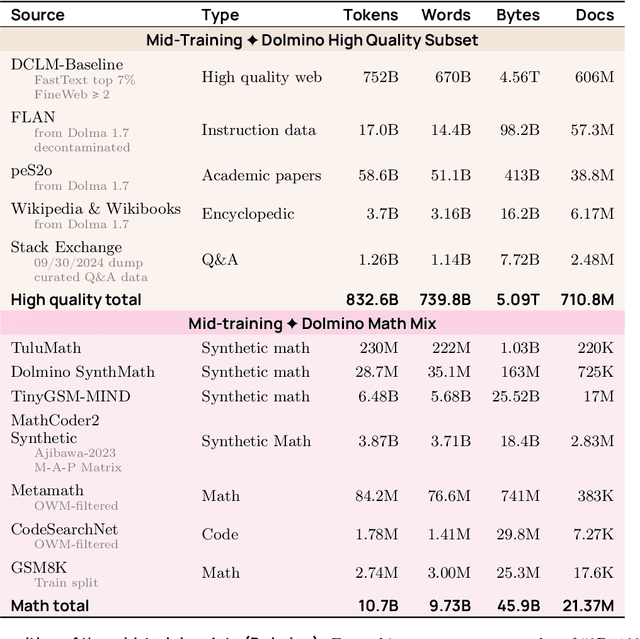
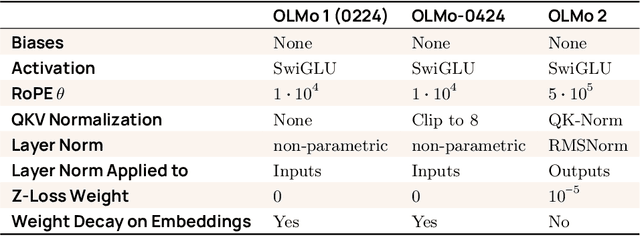

Abstract:We present OLMo 2, the next generation of our fully open language models. OLMo 2 includes dense autoregressive models with improved architecture and training recipe, pretraining data mixtures, and instruction tuning recipes. Our modified model architecture and training recipe achieve both better training stability and improved per-token efficiency. Our updated pretraining data mixture introduces a new, specialized data mix called Dolmino Mix 1124, which significantly improves model capabilities across many downstream task benchmarks when introduced via late-stage curriculum training (i.e. specialized data during the annealing phase of pretraining). Finally, we incorporate best practices from T\"ulu 3 to develop OLMo 2-Instruct, focusing on permissive data and extending our final-stage reinforcement learning with verifiable rewards (RLVR). Our OLMo 2 base models sit at the Pareto frontier of performance to compute, often matching or outperforming open-weight only models like Llama 3.1 and Qwen 2.5 while using fewer FLOPs and with fully transparent training data, code, and recipe. Our fully open OLMo 2-Instruct models are competitive with or surpassing open-weight only models of comparable size, including Qwen 2.5, Llama 3.1 and Gemma 2. We release all OLMo 2 artifacts openly -- models at 7B and 13B scales, both pretrained and post-trained, including their full training data, training code and recipes, training logs and thousands of intermediate checkpoints. The final instruction model is available on the Ai2 Playground as a free research demo.
TÜLU 3: Pushing Frontiers in Open Language Model Post-Training
Nov 22, 2024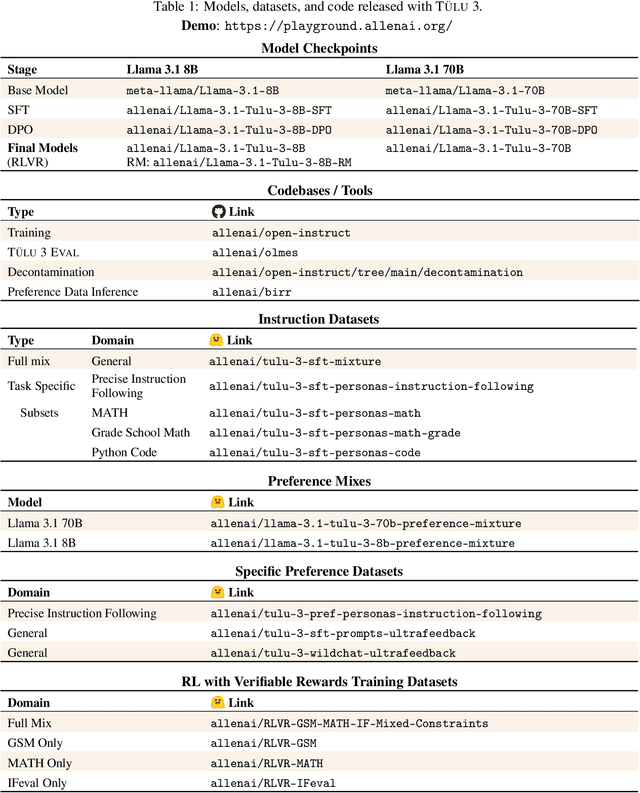



Abstract:Language model post-training is applied to refine behaviors and unlock new skills across a wide range of recent language models, but open recipes for applying these techniques lag behind proprietary ones. The underlying training data and recipes for post-training are simultaneously the most important pieces of the puzzle and the portion with the least transparency. To bridge this gap, we introduce T\"ULU 3, a family of fully-open state-of-the-art post-trained models, alongside its data, code, and training recipes, serving as a comprehensive guide for modern post-training techniques. T\"ULU 3, which builds on Llama 3.1 base models, achieves results surpassing the instruct versions of Llama 3.1, Qwen 2.5, Mistral, and even closed models such as GPT-4o-mini and Claude 3.5-Haiku. The training algorithms for our models include supervised finetuning (SFT), Direct Preference Optimization (DPO), and a novel method we call Reinforcement Learning with Verifiable Rewards (RLVR). With T\"ULU 3, we introduce a multi-task evaluation scheme for post-training recipes with development and unseen evaluations, standard benchmark implementations, and substantial decontamination of existing open datasets on said benchmarks. We conclude with analysis and discussion of training methods that did not reliably improve performance. In addition to the T\"ULU 3 model weights and demo, we release the complete recipe -- including datasets for diverse core skills, a robust toolkit for data curation and evaluation, the training code and infrastructure, and, most importantly, a detailed report for reproducing and further adapting the T\"ULU 3 approach to more domains.
Merge to Learn: Efficiently Adding Skills to Language Models with Model Merging
Oct 16, 2024



Abstract:Adapting general-purpose language models to new skills is currently an expensive process that must be repeated as new instruction datasets targeting new skills are created, or can cause the models to forget older skills. In this work, we investigate the effectiveness of adding new skills to preexisting models by training on the new skills in isolation and later merging with the general model (e.g. using task vectors). In experiments focusing on scientific literature understanding, safety, and coding, we find that the parallel-train-then-merge procedure, which is significantly cheaper than retraining the models on updated data mixtures, is often comparably effective. Our experiments also show that parallel training is especially well-suited for enabling safety features in LMs relative to continued finetuning and retraining, as it dramatically improves model compliance with safe prompts while preserving its ability to refuse dangerous or harmful prompts.
OLMoE: Open Mixture-of-Experts Language Models
Sep 03, 2024



Abstract:We introduce OLMoE, a fully open, state-of-the-art language model leveraging sparse Mixture-of-Experts (MoE). OLMoE-1B-7B has 7 billion (B) parameters but uses only 1B per input token. We pretrain it on 5 trillion tokens and further adapt it to create OLMoE-1B-7B-Instruct. Our models outperform all available models with similar active parameters, even surpassing larger ones like Llama2-13B-Chat and DeepSeekMoE-16B. We present various experiments on MoE training, analyze routing in our model showing high specialization, and open-source all aspects of our work: model weights, training data, code, and logs.
SciRIFF: A Resource to Enhance Language Model Instruction-Following over Scientific Literature
Jun 10, 2024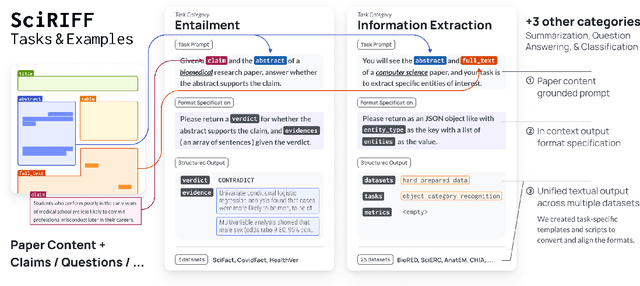
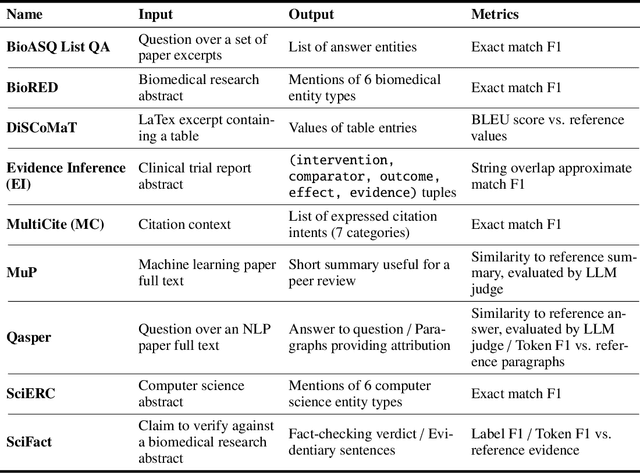


Abstract:We present SciRIFF (Scientific Resource for Instruction-Following and Finetuning), a dataset of 137K instruction-following demonstrations for 54 tasks covering five essential scientific literature understanding capabilities: information extraction, summarization, question answering, claim verification, and classification. SciRIFF demonstrations are notable for their long input contexts, detailed task specifications, and complex structured outputs. While instruction-following resources are available in specific domains such as clinical medicine and chemistry, SciRIFF is the first dataset focused on extracting and synthesizing information from research literature across a wide range of scientific fields. To demonstrate the utility of SciRIFF, we develop a sample-efficient strategy to adapt a general instruction-following model for science by performing additional finetuning on a mix of general-domain and SciRIFF demonstrations. In evaluations on nine held-out scientific tasks, our model -- called SciTulu -- improves over a strong LLM baseline by 28.1% and 6.5% at the 7B and 70B scales respectively, while maintaining general instruction-following performance within 2% of the baseline. We are optimistic that SciRIFF will facilitate the development and evaluation of LLMs to help researchers navigate the ever-growing body of scientific literature. We release our dataset, model checkpoints, and data processing and evaluation code to enable further research.
RewardBench: Evaluating Reward Models for Language Modeling
Mar 20, 2024Abstract:Reward models (RMs) are at the crux of successful RLHF to align pretrained models to human preferences, yet there has been relatively little study that focuses on evaluation of those reward models. Evaluating reward models presents an opportunity to understand the opaque technologies used for alignment of language models and which values are embedded in them. To date, very few descriptors of capabilities, training methods, or open-source reward models exist. In this paper, we present RewardBench, a benchmark dataset and code-base for evaluation, to enhance scientific understanding of reward models. The RewardBench dataset is a collection of prompt-win-lose trios spanning chat, reasoning, and safety, to benchmark how reward models perform on challenging, structured and out-of-distribution queries. We created specific comparison datasets for RMs that have subtle, but verifiable reasons (e.g. bugs, incorrect facts) why one answer should be preferred to another. On the RewardBench leaderboard, we evaluate reward models trained with a variety of methods, such as the direct MLE training of classifiers and the implicit reward modeling of Direct Preference Optimization (DPO), and on a spectrum of datasets. We present many findings on propensity for refusals, reasoning limitations, and instruction following shortcomings of various reward models towards a better understanding of the RLHF process.
OLMo: Accelerating the Science of Language Models
Feb 07, 2024
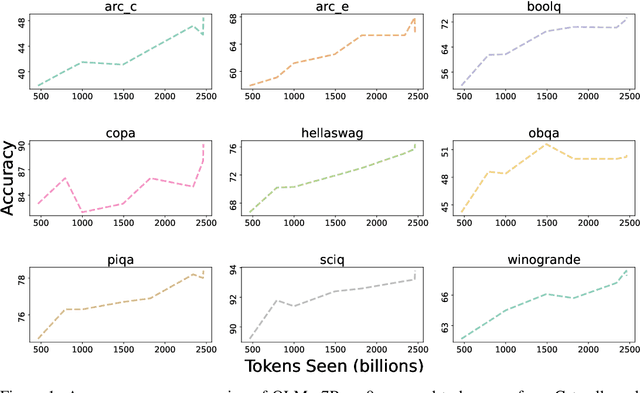
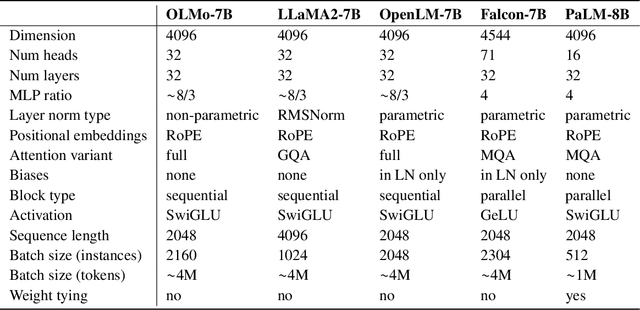
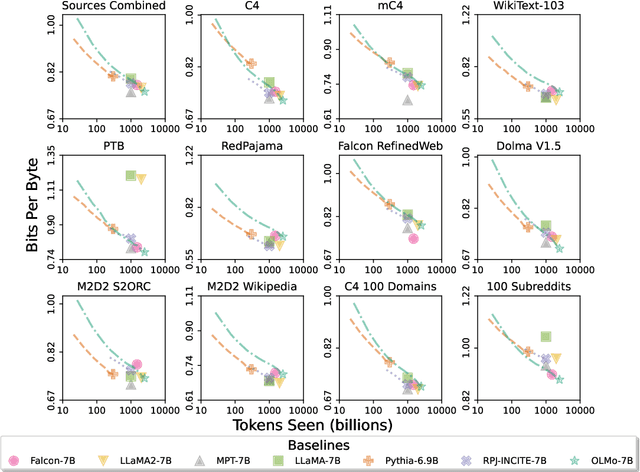
Abstract:Language models (LMs) have become ubiquitous in both NLP research and in commercial product offerings. As their commercial importance has surged, the most powerful models have become closed off, gated behind proprietary interfaces, with important details of their training data, architectures, and development undisclosed. Given the importance of these details in scientifically studying these models, including their biases and potential risks, we believe it is essential for the research community to have access to powerful, truly open LMs. To this end, this technical report details the first release of OLMo, a state-of-the-art, truly Open Language Model and its framework to build and study the science of language modeling. Unlike most prior efforts that have only released model weights and inference code, we release OLMo and the whole framework, including training data and training and evaluation code. We hope this release will empower and strengthen the open research community and inspire a new wave of innovation.
Dolma: an Open Corpus of Three Trillion Tokens for Language Model Pretraining Research
Jan 31, 2024



Abstract:Language models have become a critical technology to tackling a wide range of natural language processing tasks, yet many details about how the best-performing language models were developed are not reported. In particular, information about their pretraining corpora is seldom discussed: commercial language models rarely provide any information about their data; even open models rarely release datasets they are trained on, or an exact recipe to reproduce them. As a result, it is challenging to conduct certain threads of language modeling research, such as understanding how training data impacts model capabilities and shapes their limitations. To facilitate open research on language model pretraining, we release Dolma, a three trillion tokens English corpus, built from a diverse mixture of web content, scientific papers, code, public-domain books, social media, and encyclopedic materials. In addition, we open source our data curation toolkit to enable further experimentation and reproduction of our work. In this report, we document Dolma, including its design principles, details about its construction, and a summary of its contents. We interleave this report with analyses and experimental results from training language models on intermediate states of Dolma to share what we have learned about important data curation practices, including the role of content or quality filters, deduplication, and multi-source mixing. Dolma has been used to train OLMo, a state-of-the-art, open language model and framework designed to build and study the science of language modeling.
Bidimensional Leaderboards: Generate and Evaluate Language Hand in Hand
Dec 08, 2021



Abstract:Natural language processing researchers have identified limitations of evaluation methodology for generation tasks, with new questions raised about the validity of automatic metrics and of crowdworker judgments. Meanwhile, efforts to improve generation models tend to focus on simple n-gram overlap metrics (e.g., BLEU, ROUGE). We argue that new advances on models and metrics should each more directly benefit and inform the other. We therefore propose a generalization of leaderboards, bidimensional leaderboards (Billboards), that simultaneously tracks progress in language generation tasks and metrics for their evaluation. Unlike conventional unidimensional leaderboards that sort submitted systems by predetermined metrics, a Billboard accepts both generators and evaluation metrics as competing entries. A Billboard automatically creates an ensemble metric that selects and linearly combines a few metrics based on a global analysis across generators. Further, metrics are ranked based on their correlations with human judgments. We release four Billboards for machine translation, summarization, and image captioning. We demonstrate that a linear ensemble of a few diverse metrics sometimes substantially outperforms existing metrics in isolation. Our mixed-effects model analysis shows that most automatic metrics, especially the reference-based ones, overrate machine over human generation, demonstrating the importance of updating metrics as generation models become stronger (and perhaps more similar to humans) in the future.
Transparent Human Evaluation for Image Captioning
Nov 17, 2021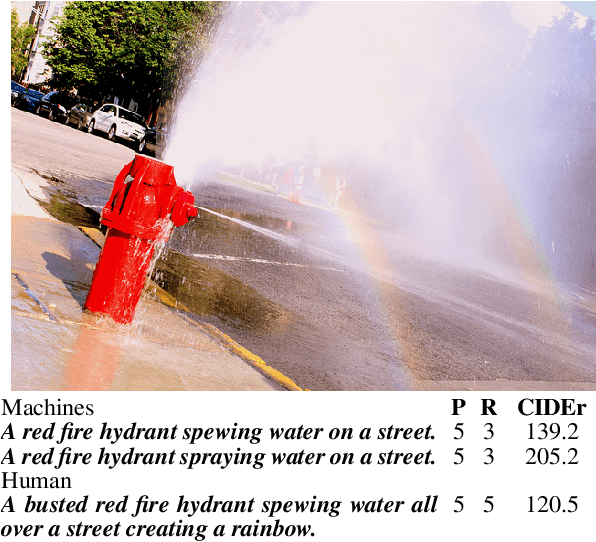
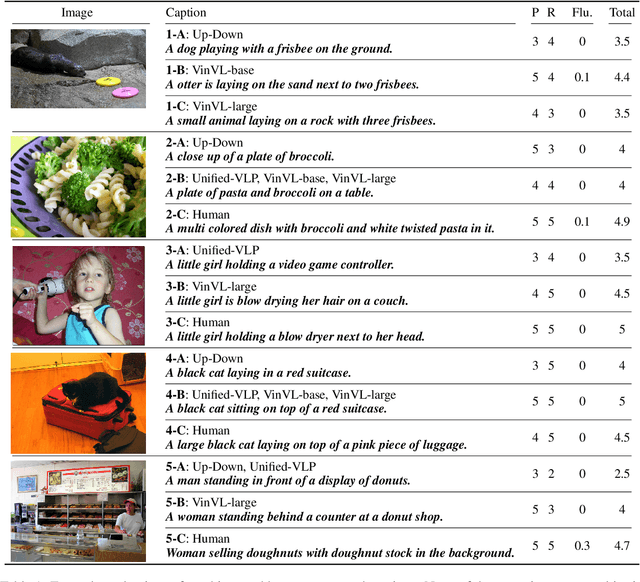

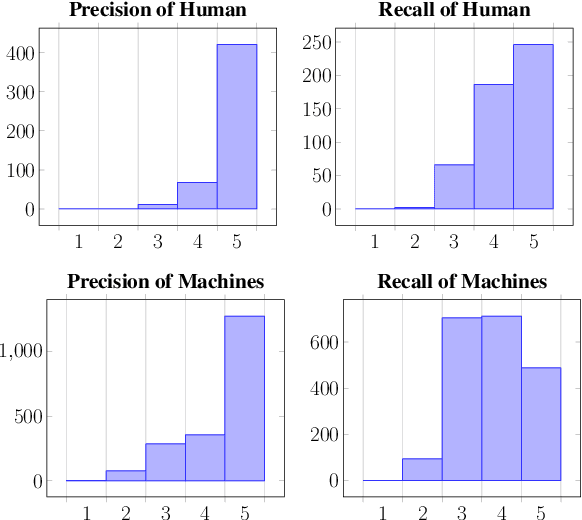
Abstract:We establish a rubric-based human evaluation protocol for image captioning models. Our scoring rubrics and their definitions are carefully developed based on machine- and human-generated captions on the MSCOCO dataset. Each caption is evaluated along two main dimensions in a tradeoff (precision and recall) as well as other aspects that measure the text quality (fluency, conciseness, and inclusive language). Our evaluations demonstrate several critical problems of the current evaluation practice. Human-generated captions show substantially higher quality than machine-generated ones, especially in coverage of salient information (i.e., recall), while all automatic metrics say the opposite. Our rubric-based results reveal that CLIPScore, a recent metric that uses image features, better correlates with human judgments than conventional text-only metrics because it is more sensitive to recall. We hope that this work will promote a more transparent evaluation protocol for image captioning and its automatic metrics.
 Add to Chrome
Add to Chrome Add to Firefox
Add to Firefox Add to Edge
Add to Edge